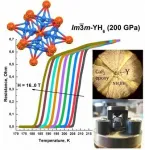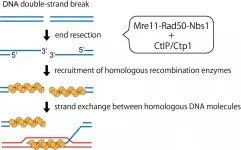Scientists have synthesized a new high-temperature superconductor
2021-03-10
(Press-News.org) An international team led by Artem R. Oganov, a Professor at Skoltech and MISIS, and Dr. Ivan Troyan from the Institute of Crystallography of RAS performed theoretical and experimental research on a new high-temperature superconductor, yttrium hydride (YH6). Their findings were published in the journal Advanced Materials.
Yttrium hydrides rank among the three highest-temperature superconductors known to date. The leader among the three is a material with an unknown S-C-H composition and superconductivity at 288 K, which is followed by lanthanum hydride, LaH10, superconducting at temperatures up to 259 K), and, finally, yttrium hydrides, YH6 and YH9, with maximum superconductivity temperatures of 224 K and 243 K, respectively. The superconductivity of YH6 was predicted by Chinese scientists in 2015. All of these hydrides reach their maximum superconductivity temperatures at very high pressures: 2.7 million atmospheres for S-C-H and about 1.4-1.7 million atmospheres for LaH10 and YH6. The high pressure requirement remains a major roadblock for quantity production.
"Until 2015, 138 K (or 166 K under pressure) was the record of high-temperature superconductivity. Room-temperature superconductivity, which would have been laughable just five years ago, has become a reality. Right now, the whole point is to attain room-temperature superconductivity at lower pressures," says Dmitry Semenok, a co-author of the paper and a PhD student at Skoltech.
The highest-temperature superconductors were first predicted in theory and then created and investigated experimentally. When studying new materials, chemists start by making theoretical predictions and then testing new material in practice.
"First, we look at the bigger picture and study a multitude of different materials on the computer. This makes things much faster. More detailed calculations follow the initial screening. Sorting through fifty or a hundred materials takes about a year, while an experiment with a single material of particular interest may last a year or two," Oganov comments.
Typically, critical superconductivity temperatures are predicted by theory with an error of about 10-15%. Similar accuracy is achieved in critical magnetic field predictions. In the case of YH6, the agreement between theory and experiment is rather poor. For example, the critical magnetic field observed in the experiment is 2 to 2.5 times greater as compared to theoretical predictions. This is the first time scientists encounter such a discrepancy which is yet to be explained. Perhaps, some additional physical effects contribute to this material's superconductivity and were not accounted for in theoretical calculations.
INFORMATION:
[Attachments] See images for this press release:

ELSE PRESS RELEASES FROM THIS DATE:
2021-03-10
Boston - A new study shows that providing a non-acute care space after hospital discharge for patients with COVID-19 who are experiencing homelessness helped reduce hospitalizations and keep inpatient beds available for those requiring acute care. Published in JAMA Network Open and led by researchers at Boston Medical Center's (BMC) Grayken Center for Addiction, the study demonstrates the importance of developing innovative approaches to tackle issues facing people experiencing homelessness, including their inability to isolate, in order to mitigate additional ...
2021-03-10
Associations between strong predictors of suicidal behaviors over the life course, such as adverse childhood events (ACEs), remain understudied among youth of color. Although not previously considered high risk, suicide attempts among Black youth increased 73% between 1991 and 2017.
Published in the Children and Youth Services Review, University of Minnesota researchers pulled data from the 2016 Minnesota Student Survey (MSS) to examine associations between ACEs, school connectedness and suicide ideation and attempts among Somali, Latino, Hmong and Non-Hispanic ...
2021-03-10
Research published in Environmental Toxicology and Chemistry shows that the presence of polybrominated diphenyl ethers (PBDEs) in bald eagle populations is slowly declining. Bald eagles are apex predators that nest and, more importantly, feed along water bodies, making them excellent bioindicators of environmental contaminants that bioaccumulate up the aquatic food web. The findings are both good news for eagles and instructive for regulators tasked with managing surface water quality by setting protective levels for wildlife, as well as fish consumption advisories for humans.
Lead author Bill Route from the National ...
2021-03-10
Scientists at Tokyo Institute of Technology (Tokyo Tech) have uncovered mechanisms underlying the activation of the MRN complex-- the cell's DNA scissors. Using purified yeast proteins, they demonstrated that phosphorylation of Ctp1, a homolog of a tumor-suppressor protein, plays a key role in activating MRN complex's DNA clipping activity. Intriguingly, a short segment of yeast Ctp1 or its human counterpart could stimulate endonuclease activity of their respective MRN complexes, suggesting its conserved function across species.
DNA functions as a roadmap that guides the identity and functions of cells. A glitch in the DNA ...
2021-03-10
BINGHAMTON, NY -- Star employees often get most of the credit when things go right, but also shoulder most of the blame when things go wrong, according to new research from Binghamton University, State University of New York.
The study explored the potential risks and rewards of collaborating with stars - individuals who have a reputation for exhibiting exceptional performance - and how individual performance factors into how much credit and blame is shared with collaborators.
"Stars are human, and they fail from time to time. We wanted to shift the focus away from stars, and find out what happens to the people who collaborate ...
2021-03-10
ALBUQUERQUE, N.M. -- Geoscientists at Sandia National Laboratories used 3D-printed rocks and an advanced, large-scale computer model of past earthquakes to understand and prevent earthquakes triggered by energy exploration.
Injecting water underground after unconventional oil and gas extraction, commonly known as fracking, geothermal energy stimulation and carbon dioxide sequestration all can trigger earthquakes. Of course, energy companies do their due diligence to check for faults -- breaks in the earth's upper crust that are prone to earthquakes -- but sometimes ...
2021-03-10
Eye contact is a key to establishing a connection, and teachers use it often to encourage participation. But can a robot do this too? Can it draw a response simply by making "eye" contact, even with people who are less inclined to speak up. A recent study suggests that it can.
Researchers at KTH Royal Institute of Technology published results of experiments in which robots led a Swedish word game with individuals whose proficiency in the Nordic language was varied. They found that by redirecting its gaze to less proficient players, a robot can elicit involvement from even the most reluctant participants.
Researchers Sarah Gillet and Ronald Cumbal say the results offer evidence that robots could play a productive role in educational settings.
Calling on someone by name isn't ...
2021-03-10
The protein α-synuclein is one of the most abundant proteins in the human brain. It is often referred to as the "Parkinson protein", as deposition of this protein in brain cells is a hallmark of Parkinson's disease. Despite the high interest of biomedical research in the protein, many questions concerning the function and physiology of α-synuclein in living cells still remain to be answered. For example, it was previously unclear whether and to what extent the protein binds to and interacts with internal cell components such as membranes. As such processes could play a role in the development of the disease, the team led by Konstanz-based physical chemist Professor Malte Drescher used the further development of an established measurement method called ...
2021-03-10
An article published by the researchers of the Biodiversity Unit at the University of Turku, Finland, highlights how amateur venom-extraction business is threatening scorpion species. Sustainably produced scorpion venoms are important, for example, in the pharmacological industry. However, in the recent years, there has been a dramatic increase in the number of people involved in the trade and vast numbers of scorpions are harvested from nature. This development is endangering the future of several scorpion species in a number of areas.
Scorpions have existed on Earth for over 430 million years. Currently comprising over 2,500 extant species, scorpions occur on almost all the major landmasses in a range of habitats from ...
2021-03-10
Gravity is the weakest of all known forces in nature - and yet it is most strongly present in our everyday lives. Every ball we throw, every coin we drop - all objects are attracted by the Earth's gravity. In a vacuum, all objects near the Earth's surface fall with the same acceleration: their velocity increases by about 9.8 m/s every second. The strength of gravity is determined by the mass of the Earth and the distance from the center. On the Moon, which is about 80 times lighter and almost 4 times smaller than the Earth, all objects fall 6 times slower. And on a planet of the size of a ladybug? ...
LAST 30 PRESS RELEASES:
[Press-News.org] Scientists have synthesized a new high-temperature superconductor




